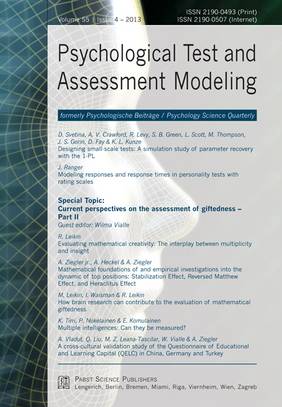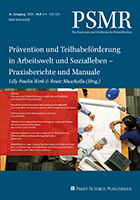Psychological Test and Assessment Modeling, Volume 55, 2013 (4)
Designing small-scale tests: A simulation study of parameter recovery with the 1-PL
Dubravka Svetina, AAron V. Crawford, Roy Levy, Samuel B. Green, Lietta Scott, Marilyn Thompson, Joanna S. Gorin, Derek Fay & Katie L. Kunze
Abstract | ![]() PDF of the full article
PDF of the full article
Modeling responses and response times in personality tests with rating scales
Jochen Ranger
Abstract | ![]() PDF of the full article
PDF of the full article
Special Topic:
Current perspectives on the assessment of giftedness - Part II
Guest editor: Wilma Vialle
Guest edtiorial
Wilma Vialle![]() PDF of the full article
PDF of the full article
Evaluating mathematical creativity: The interplay between multiplicity and insight
Roza Leikin
Abstract | ![]() PDF of the full article
PDF of the full article
Mathematical foundations of and empirical investigations into the dynamic of top positions: Stabilization Effect, Reversed Matthew Effect, and Heraclitus Effect
Albert Ziegler jr., Annika Heckel & Albert Ziegler
Abstract | ![]() PDF of the full article
PDF of the full article
How brain research can contribute to the evaluation of mathematical giftedness
Mark Leikin, Ilana Waisman & Roza Leikin
Abstract | ![]() PDF of the full article
PDF of the full article
Multiple intelligences: Can they be measured?
Kirsi Tirri, Petri Nokelainen & Erkki Komulainen
Abstract | ![]() PDF of the full article
PDF of the full article
A cross-cultural validation study of the Questionnaire of Educational and Learning Capital (QELC) in China, Germany and Turkey
Anamaria Vladut, Qian Liu, Marilena Z. Leana-Tascilar, Wilma Vialle & Albert Ziegler
Abstract | ![]() PDF of the full article
PDF of the full article
Designing small-scale tests: A simulation study of parameter recovery with the 1-PL
Dubravka Svetina, Aron V. Crawford, Roy Levy, Samuel B. Green, Lietta Scott, Marilyn Thompson, Joanna S. Gorin, Derek Fay & Katie L. Kunze
Abstract
This simulation study investigated the recovery of item and person parameters of the one-parameter logistic model for short tests administered to small samples. A potential problem with such small scale testing is the mismatch between item and person location parameter distributions. In our study, we manipulated the match of these distributions as well as test length, sample size, and item discrimination. Results showed the degree of mismatch likely to occur in practice has a relatively modest effect on parameter recovery. As expected, accuracy in parameter estimation decreased as sample size and test length decreased. Nevertheless, researchers investigating small scale tests are likely to view parameter recovery as acceptable if a study has at least 100 subjects and 8 items.
Key words: parameter recovery, mismatch of item and person location distributions, small-scale assessments, item response theory, simulation study
Dubravka Svetina, PhD
201 N. Rose Avenue
Indiana University
Bloomington, IN 47405
dsvetina@indiana.edu
Modeling responses and response times in personality tests with rating scales
Jochen Ranger
Abstract
In this article several latent trait models for the joint distribution of the responses and response times in rating scales are compared. Among these models are two generalizations of established models for binary items, namely a generalization of the approach of Ferrando and Lorenzo-Seva (2007a) and a generalization of the approach of Ranger and Ortner (2011). Two new models and a variant of the hierarchical model of van der Linden (2007) are also considered. All these models combine the graded response model with a response time model based on the log-normal distribu-tion. The models differ in the assumed relationship between the expected log response time and the underlying latent traits. Although the proposed models have different interpretations and implications they can all be calibrated within the same general framework using marginal maximum likelihood estimation and an application of the ECM-algorithm. The models are used for the analysis of an empirical data set. According to the AIC index, the generalization of the model of Ranger and Ortner (2011) can represent the data best.
Keywords: response time, log-normal distribution, inverted U shaped relationship, rating scale
Jochen Ranger, PhD
Martin-Luther-Universität Halle-Wittenberg
Institut für Psychologie
Brandbergweg 23c
06120 Halle (Saale), Germany
jochen.ranger@psych.uni-halle.de
Evaluating mathematical creativity: The interplay between multiplicity and insight
Roza Leikin
Abstract
This paper presents an original model for evaluation of mathematical creativity. I describe different stages of the model's development and justify critical decisions taken throughout, based on the analysis of the model's implementation. The model incorporates an integrative theoretical framework that was developed based on works devoted to both general and mathematical creativity. The scoring scheme for the evaluation of creativity, which is an important part of the model, combines an examination of both divergent and convergent thinking as reflected in problem solving processes and outcomes. The theoretical connection between creativity and divergent thinking is reflected in the multiplicity component of the model, which is based on the explicit requirement to solve mathematical problems in multiple ways. It is evaluated for fluency and flexibility. The connection between creativity and convergent thinking is reflected in the component of insight, which is based on the possibility to produce insight-based solutions to mathematical problems. I provide examples of the study in which the model is used to examine differences in creativity of students with different levels of excellence in mathematics and different levels of general giftedness.
Key words: Creativity, multiplicity, insight, giftedness, excellence
Prof. Roza Leikin
Faculty of Education
University of Haifa
Haifa, 31905, Israel
rozal@edu.haifa.ac.il
Mathematical foundations of and empirical investigations into the dynamic of top positions: Stabilization Effect, Reversed Matthew Effect, and Heraclitus Effect
Albert Ziegler jr., Annika Heckel & Albert Ziegler
Abstract
The performance differences between successively ranked individuals tend to increase towards the top. However, the mathematical foundations of this effect are still largely untapped. This article will focus on developing such foundations. It will also be shown that the effect is stable for various natural distributions of eminent achievements. Three new predictions about the dynamics of top positions are formulated and tested with two samples from the world of sports: the best male chess players (individual sport) and male national soccer teams. The stabilization effect describes the phenomenon that the stability of ranks is higher among the top ranks. The reversed Matthew effect asserts that achievement gains among elite players and elite teams are positively correlated with their ranks (i.e. diminishing towards the top). However, in contrast, the Heraclitus effect predicts that the performance gains among the top ranks are nevertheless bigger than what can be mathematically expected from the position in the ranking. All three effects can be empirically corroborated.
Keywords: Top positions, Eminence, Stabilization Effect, Reversed Matthew Effect, Heraclitus Effect
Albert Ziegler, PhD
School of Mathematics
University of Leeds
Leeds, LS2 9JT, UK
mmaz@leeds.ac.uk
How brain research can contribute to the evaluation of mathematical giftedness
Mark Leikin, Ilana Waisman & Roza Leikin
Abstract
In this paper we suggest that instruments of neuro-cognitive research enable the evaluation of giftedness in mathematics. We start with a literature review on the related topics presented so as to situate our suggestions within the existing research on giftedness and excellence in mathematics. This literature review allows us later to discuss our findings, which are based on neurocognitive data collected in a large-scale multidimensional examination of mathematical giftedness. Sampling procedure in the study was performed based on two orthogonal (in our view) characteristics: general giftedness (G) and excellence in mathematics (EM). In this paper we present findings that lead to a definition of the mathematically gifted population. We present selected results to provide evidence for our findings. In this paper we demonstrate three major findings:
A. Effects of G and EM factors are task-dependent both in behavioral and neurophysiological measures: the EM factor has significant main effects on tasks that require implementation of knowledge familiar to students from school mathematics. By contrast, the G factor has a significant main effect on insight-based problems which are not part of the school mathematical curriculum and, thus, require original mathematical reasoning.
B. Mathematical performance in gifted students who excel in mathematics (G-EM students) on insight-based tasks has specific characteristics in both behavioral and electrophysiological results.
C. G-EM participants exhibited superior performance in all the tests, showing a constant neuro-efficiency effect.
Based on these observations we suggest that mathematically gifted students are those who are both generally gifted and excel in mathematics.
Key words: Giftedness, Excellence in mathematics, Neurocognition, Evaluation, Problem solving
Prof. Mark Leikin
Faculty of Education
University of Haifa
Haifa, 31905, Israel
markl@edu.haifa.ac.il
Multiple intelligences: Can they be measured?
Kirsi Tirri, Petri Nokelainen & Erkki Komulainen
Abstract
This paper is about issues relating to the assessment of multiple intelligences. The first section introduces the authors work on building measures of multiple intelligences and moral sensitivities. It also provides a conceptual definition of multiple intelligences based on Multiple Intelligences theory by Howard Gardner (1983). The second section discusses the context specificity of intelligences and alternative approaches to measuring multiple intelligences. The third section analyses the validity of self-evaluation instruments and provides a case example of building such an instrument. The paper ends with concluding remarks.
Key words: Giftedness, multiple intelligences theory, MIPQ, CFA, Bayesian modeling
Prof. Kirsi Tirri, PhD, MTh
Department of Teacher Education
Faculty of Behavioral Sciences
P. O. Box 9 (Siltavuorenpenger 5 A)
FI-00014 University of Helsinki, Finland
kirsi.tirri@helsinki.fi
A cross-cultural validation study of the Questionnaire of Educational and Learning Capital (QELC) in China, Germany and Turkey
Anamaria Vladut, Qian Liu, Marilena Z. Leana-Tascilar, Wilma Vialle & Albert Ziegler
Abstract
Unlike traditional person-centered models of giftedness, the Actiotope Model of Giftedness focuses on the person-environment interactions. It postulates that successful learning requires necessary resources, termed educational and learning capital, located both in the environment and the individual. The Questionnaire of Educational and Learning Capital (QELC) is introduced. The results of a validation study with students from China, Turkey and Germany is reported which shows that the QELC has satisfactory psychometric properties as well as construct and concurrent validity.
Keywords: Giftedness, actiotope, QELC, cross-cultural study
Anamaria Vladut
Department of Psychology
University of Erlangen-Nuremberg
Dutzendteichstr. 24
90478 Nuremberg, Germany
anamaria.vladut@fau.de























